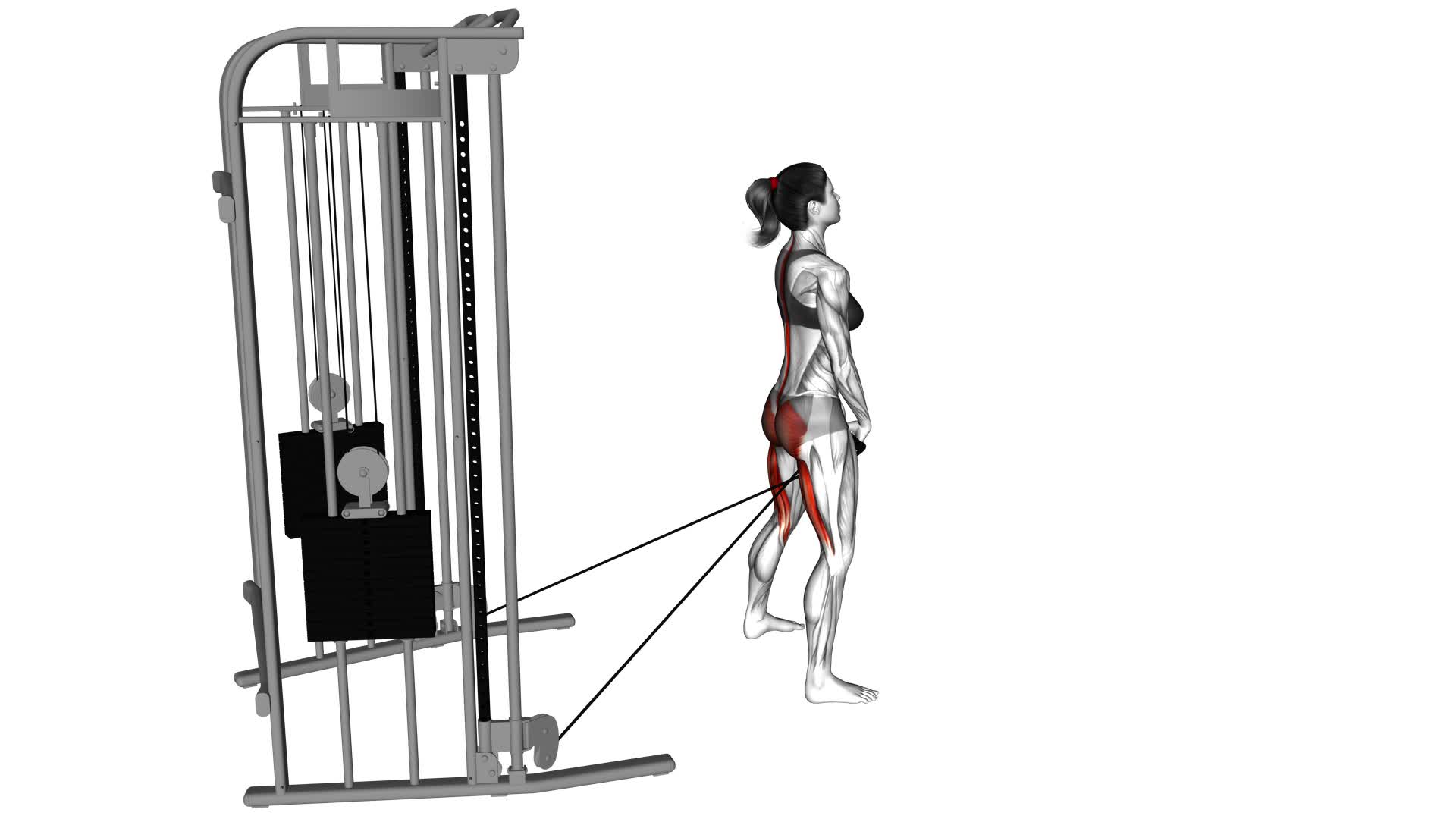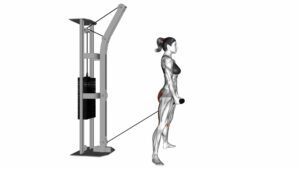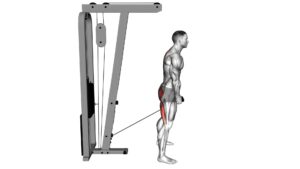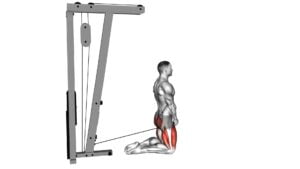Cable Pull Through (female) – Video Exercise Guide & Tips

Looking to strengthen your glutes and get a toned lower body? Look no further than the Cable Pull Through. This exercise targets your posterior chain and can be done with just a cable machine.
Watch This Exercise Video
In this video exercise guide, we'll show you the proper form and technique, variations to keep it challenging, and tips for maximizing results. Say goodbye to common mistakes and hello to a more effective workout.
Let's get started!
Key Takeaways
- Cable pull through targets multiple muscle groups including the glutes, hamstrings, and core.
- It improves core stability and enhances hip mobility.
- Cable pull through can be performed using a cable machine with low attachment point, or with alternative equipment such as resistance bands or kettlebells.
- Proper form and technique, including maintaining a straight back and avoiding rounding the lower back, are important for effective and safe execution of the exercise.
Benefits of Cable Pull Through
- Discover five key benefits of incorporating the Cable Pull Through into your fitness routine.
The Cable Pull Through is a versatile exercise that targets multiple muscle groups, making it an effective addition to any fitness routine. Here are five key benefits of incorporating this exercise into your workouts:
- Glute Activation: The Cable Pull Through primarily targets the glutes, helping to activate and strengthen these muscles. Strong glutes not only enhance your aesthetic appearance but also improve athletic performance and reduce the risk of injury.
- Hamstring Development: In addition to targeting the glutes, the Cable Pull Through also engages the hamstrings. This helps to develop strength and stability in the back of your legs, improving overall lower body strength.
- Core Stability: The Cable Pull Through requires you to engage your core muscles to maintain proper form throughout the movement. This helps to improve core stability and enhance overall functional strength.
- Hip Mobility: As you perform the Cable Pull Through, your hips go through a full range of motion. This helps to improve hip mobility and flexibility, which is essential for various daily activities and exercises.
- Variation Options: The Cable Pull Through offers a range of variations to target different muscle groups and add variety to your workouts. You can perform the exercise with different attachments, such as a rope or handle, to emphasize certain muscles or challenge your body in new ways.
Incorporating the Cable Pull Through into your fitness routine can provide these key benefits and help you reach your fitness goals more effectively.
Equipment Needed for Cable Pull Through
To perform the cable pull through exercise, you'll need a cable machine with a low attachment point and a handle or rope attachment. These are the essential equipment for this exercise.
However, if you don't have access to a cable machine, you can use alternative equipment like resistance bands or a kettlebell to achieve a similar movement and target the same muscle groups.
Essential Equipment for Pull Through
You will need a cable machine for the pull through exercise. The cable machine consists of a weight stack, pulleys, and cables that allow you to adjust the resistance. This equipment is essential for performing cable pull through variations, which can help you target different muscles and add variety to your workout routine.
To get the most out of your cable pull through, it's important to follow some tips. First, make sure to set the cable at an appropriate height and adjust the weight according to your strength level. Additionally, maintain proper form throughout the exercise by keeping your back straight, bending at the hips, and engaging your glutes and hamstrings. Finally, control the movement and avoid using momentum to ensure that you're effectively targeting the intended muscles.
Alternatives to Cable Equipment
If you don't have access to a cable machine, there are alternative options for equipment needed to perform the cable pull through exercise. Don't worry, you can still work those glutes and hamstrings without the cable equipment.
There are several alternate exercises you can do that rely solely on your bodyweight. One option is the bodyweight hip thrust, where you lie on your back with your knees bent and feet flat on the ground. Lift your hips up towards the ceiling, squeezing your glutes at the top.
Another option is the glute bridge, where you perform a similar movement but with your feet planted on the ground. Both of these exercises target the same muscle groups as the cable pull through and can be just as effective in building strength and stability.
Proper Form and Technique for Cable Pull Through
Proper form and technique are crucial to maximize the effectiveness of the Cable Pull Through and minimize the risk of injury. To start, let's address some common mistakes that people often make.
- One mistake is rounding the lower back during the movement. This not only reduces the effectiveness of the exercise but also puts unnecessary strain on the spine. To avoid this, focus on keeping your back straight and maintaining a neutral spine throughout the entire movement.
- Another mistake is using too much weight and sacrificing form. It's important to start with a weight that allows you to maintain proper form and gradually increase the resistance as you get stronger. Adjusting the resistance is easy with the cable machine. Simply select the appropriate weight by attaching the cable to the desired height on the machine.
Remember, it's better to start light and gradually increase the resistance rather than starting too heavy and risking injury.
Variations of Cable Pull Through
To further enhance your Cable Pull Through exercise, try incorporating different variations of the movement.
Adding variations to your workout routine can help target different muscle groups and prevent boredom.
One variation you can try is the single-leg cable pull through. Instead of using both legs, lift one leg off the ground and perform the exercise with the other leg. This variation not only challenges your glutes and hamstrings, but also engages your core for stability.
Another variation is the banded cable pull through. Attach a resistance band to the cable machine and loop it around your waist. This adds extra resistance to the movement, making it more challenging and effective for building strength.
Additionally, you can experiment with different foot positions, such as wide stance or narrow stance, to target different areas of your glutes and legs.
Incorporating these variations into your Cable Pull Through routine will provide you with a well-rounded workout and help you achieve maximum benefits.
Tips for Maximizing Results With Cable Pull Through
To maximize your results with the cable pull through, focus on proper form techniques, such as maintaining a neutral spine and engaging your glutes and hamstrings throughout the movement.
Additionally, adjust the weight resistance to challenge yourself without sacrificing form.
Remember to breathe properly, exhaling as you pull the cable through and inhaling as you return to the starting position.
Proper Form Techniques
Maximize your results with the cable pull through by utilizing proper form techniques. Avoid common mistakes that can hinder your progress and make the most out of this exercise.
First and foremost, ensure that your feet are shoulder-width apart and firmly planted on the ground. This will provide stability and prevent any unnecessary strain on your lower back.
Maintain a slight bend in your knees throughout the movement to engage your glutes effectively. Keep your core tight and your chest up, with your shoulders pulled back.
As you pull the cable through your legs, focus on squeezing your glutes at the top of the movement. Remember to control the weight and maintain a smooth, fluid motion.
Adjusting Weight Resistance
To maximize your results with the cable pull through, you can adjust the weight resistance using a variety of methods.
Adjusting the weight resistance allows you to modify the intensity of the exercise, making it more challenging or easier based on your fitness level and goals.
One way to adjust the weight resistance is by adding or removing weight plates from the cable machine. Adding more weight will increase the resistance and make the exercise more difficult, while removing weight will decrease the resistance and make it easier.
Another method is to change the distance between your body and the cable machine. Standing farther away will increase the resistance, while standing closer will decrease it.
Experiment with different weight resistances to find the level that challenges you and helps you achieve your fitness goals.
Breathing and Core Engagement
For optimal results with the cable pull through, focus on your breathing and engage your core throughout the exercise. Proper breathing technique is essential to ensure efficient oxygen flow to your muscles and maintain stability. As you perform the movement, inhale deeply through your nose during the eccentric phase (when you're bending forward) and exhale forcefully through your mouth during the concentric phase (when you're standing up). This rhythmic breathing pattern helps you generate power and maintain control.
Additionally, engaging your core throughout the exercise is crucial for stability and preventing lower back strain. Activate your core by drawing your belly button towards your spine and maintaining a neutral spine position. By incorporating proper breathing and core activation, you can maximize the effectiveness of the cable pull through and achieve optimal results.
Now, let's move on to the next section where we'll discuss common mistakes to avoid with the cable pull through.
Common Mistakes to Avoid With Cable Pull Through
You should avoid these common mistakes when performing the cable pull through exercise. One common mistake is using too much weight. It's important to start with a weight that allows you to maintain proper form and control throughout the movement. Using too heavy of a weight can lead to poor technique and increase the risk of injury.
Another mistake to avoid is rounding your back. Keep your spine in a neutral position throughout the exercise. Rounding your back can put extra stress on your lower back and decrease the effectiveness of the exercise. Focus on engaging your core and maintaining good posture.
In addition, avoid pulling the cable with your arms. The movement should primarily come from your hips and glutes. Engage your glutes and drive your hips forward to initiate the movement. Pulling with your arms can take the focus away from the intended muscle groups and reduce the effectiveness of the exercise.
To improve your form, start with lighter weights and focus on mastering the technique. Gradually increase the weight as you become more comfortable and confident with the movement. Remember to maintain a neutral spine and engage your glutes throughout the exercise.
Frequently Asked Questions
Are There Any Age Restrictions or Limitations for Performing the Cable Pull Through Exercise?
There aren't any age restrictions or limitations for performing the cable pull through exercise. It's a versatile exercise that can be modified to suit different fitness levels and abilities.
However, it's important to start with lighter weights and focus on proper form and technique to avoid injury. As you gain strength and confidence, you can gradually increase the weight and intensity of the exercise.
Remember to always listen to your body and consult with a fitness professional if you have any concerns.
How Long Should I Rest Between Sets of Cable Pull Throughs?
Rest duration between sets of cable pull throughs is an important factor in maximizing your workout. To maintain proper form and effectiveness, it's recommended to rest for about 60 to 90 seconds between sets. This allows your muscles to recover and prevents overexertion.
However, listen to your body and adjust the rest time accordingly. Remember, proper form is key to avoiding injuries and getting the most out of your cable pull through exercise.
Can the Cable Pull Through Exercise Be Modified for Individuals With Lower Back Issues?
To modify the cable pull through for lower back issues, you can try using a lighter weight and focusing on proper form. Instead of pulling the cable through your legs, you can perform the exercise with a shorter range of motion. This will help avoid excessive strain on your lower back.
The cable pull through is a great exercise for targeting your glutes and hamstrings. It helps strengthen and tone these muscles, improving your overall lower body strength and stability.
What Are Some Alternative Exercises That Target Similar Muscle Groups as the Cable Pull Through?
Looking for alternative exercises that target similar muscle groups as the cable pull through? There are a few options worth considering.
Try incorporating exercises like kettlebell swings, glute bridges, or single-leg deadlifts into your routine. These exercises engage the glutes, hamstrings, and lower back, just like the cable pull through.
Remember to start with lighter weights and focus on proper form to avoid further strain on your lower back.
Is It Necessary to Warm up Before Performing the Cable Pull Through Exercise?
Before performing the cable pull through exercise, warming up is essential. It helps prepare your muscles for the activity and reduces the risk of injury. Warming up can be done through light cardio exercises or dynamic stretches.
As for cable pull through variations, there are several options you can try to target similar muscle groups. It's always a good idea to consult with a fitness professional to ensure proper form and technique.
Conclusion
In conclusion, the cable pull through is a highly effective exercise for targeting the glutes and hamstrings. By using the proper form and technique, you can maximize your results and avoid common mistakes.
With variations available, you can customize the exercise to your fitness level and goals.
Incorporating the cable pull through into your workout routine can help strengthen and tone your lower body, leading to improved athletic performance and overall fitness.

Author
Years ago, the spark of my life’s passion ignited in my mind the moment I stepped into the local gym for the first time. The inaugural bead of perspiration, the initial endeavor, the very first surge of endorphins, and a sense of pride that washed over me post-workout marked the beginning of my deep-seated interest in strength sports, fitness, and sports nutrition. This very curiosity blossomed rapidly into a profound fascination, propelling me to earn a Master’s degree in Physical Education from the Academy of Physical Education in Krakow, followed by a Sports Manager diploma from the Jagiellonian University. My journey of growth led me to gain more specialized qualifications, such as being a certified personal trainer with a focus on sports dietetics, a lifeguard, and an instructor for wellness and corrective gymnastics. Theoretical knowledge paired seamlessly with practical experience, reinforcing my belief that the transformation of individuals under my guidance was also a reflection of my personal growth. This belief holds true even today. Each day, I strive to push the boundaries and explore new realms. These realms gently elevate me to greater heights. The unique combination of passion for my field and the continuous quest for growth fuels my drive to break new ground.







